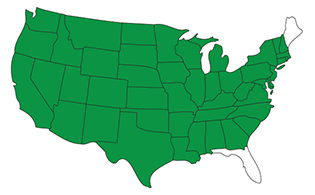
Bluegrass Billbug
Sphenophorus parvulus
The Bluegrass Billbug is a lawn pest that attacks Kentucky Bluegrass, Perennial Ryegrass, Fine Fescue and Tall Fescue. Its scientific name is Sphenophorus parvulus, and it can be found throughout most of the continental United States.
Identify

Crown & Thatch
You can easily identify an adult Bluegrass Billbug by its long, beak-like snout with chewing mouthparts at the tip. Its hard body is slate-gray to black in color, though it can sometimes appear reddish-brown from the dried soil on the body. This lawn pest also features elbowed antennae attached near the base of its snout. Bluegrass Billbug larvae are fat, legless, creamy white grubs with brown heads. Larvae are most often found inside grass stems or on the crown of the plant. The first sign of Bluegrass Billbug damage is typically scattered dead stems, followed by brown patches of grass as areas of your lawn start to die out. To check for this lawn-destroying insect in your lawn, perform a "tug test" by pulling up a small section of your grass. If Bluegrass Billbugs are present in your lawn, you will find hollowed-out stems with sawdust-like frass. Damage from a Bluegrass Billbug infestation is often mistaken for drought stress, Dollar Spot, Greenbug Damage or White Grub damage. You can tell this particular lawn-destroying insect apart from other lawn pest damage by the affected grass's whiter color, rather than the burnt orange associated with Greenbugs. Additionally, the soil in damaged areas will remain firm, as opposed to loose and spongy as you would find with a White Grub infestation.
Life Cycle
The Bluegrass Billbug overwinters as an adult. When it's time to expand the population, this lawn pest inserts single eggs into holes chewed into grass stems, just above the crown. When Bluegrass Billbug eggs hatch, the larvae bore up and down the stem, making it hollow. Each larva then burrows 3 to 4 inches into the soil to pupate.

Control
There are two methods for controlling Bluegrass Billbugs that TruGreen® recommends: 1. Use professionally applied pest control designed to prevent excess lawn pest populations, which can cause damage to your lawn 2. Kill insects, grubs and other lawn pests before they have a chance to damage your lawn Proper mowing and watering techniques can also help foster a healthy lawn that's more tolerant to lawn pest attacks—plus you'll get a lawn you'll want to live on in the process.
Featured Common
Yes




Facebook
X
Youtube
Copy Link
Email